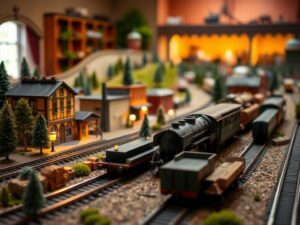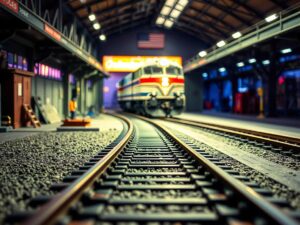Creating Military-Themed HO Scale Layouts
Creating Military-Themed HO Scale Layouts
Building the Ultimate Military HQ: Creating a Stellar HO Scale Layout
Ever dreamt of recreating iconic WWII battles on your coffee table, or transporting troops through a sprawling Korean War front line? Welcome to the exciting world of military model railroading in HO scale! Building a diorama that captures the gritty realism and strategic intricacies of war might sound intimidating, but with the right approach and a touch of creative passion, it’s entirely achievable. This article is your roadmap, packed with technical advice and inspiring ideas to get you started on your own epic military HO scale layout.
Step 1: Planning Your Campaign
Before laying down a single track, envision your battlefield.
- Historical Period: World War II? The Cold War? Vietnam? Choose a specific conflict that excites you, as this will dictate the aesthetics, vehicles, and operational focus of your layout.
- Scenario: Think about the “story” you want to tell. Is it a decisive offensive, a quiet reconnaissance mission, or a desperate stand against overwhelming odds? This narrative thread will guide your design choices.
- Terrain: Maps, historical photos, and model kits are invaluable resources for understanding typical landscapes of your chosen conflict. Consider mountains, deserts, jungles, urban environments, and the impact terrain has on tactical maneuvers.
Step 2: Track it Down (and Secure a Platform)
- Scale & Gauge: HO scale (1:87) is the gold standard for detail and model availability. The typical gauge used in warzone settings is “O Scale (gauge 36 inch)” but HO scale “Code 55”, which can also handle heavy rolling stock, offers good compatibility with your models.
- Layout Type: Choose between a point-to-point layout for showcasing fast-moving convoys and engagements or a figure-eight design for a more dynamic operation with constant back-and-forth action. Remember to account for space limitations!
Step 3: Constructing the Terrain of War
Forget flat, boring fields; your military layout demands immersive terrain:
- Basing Material: Begin by creating a solid foundation using plywood, foam board, or plastercloth, tailored to your desired map contours.
- Groundcover: Sculpt rolling hills, deep trenches, craters from bombing runs, and riverbeds using materials like clump foliage, model railroad ballast, sand, gravel, and cork bark. Experiment with texturing sprays and paint for realistic effects.
- Buildings & Structures: Utilize commercially available model kits or 3D printing for essential buildings: army barracks, supply depots, bombed-out homes, fortifications, command centers, bunkers. Incorporate details like barbed wire fences, sandbags, machine gun nests, watchtowers, and wrecked vehicles to enhance the tactical atmosphere.
- Paint and Weathering: Don’t skimp on the finishing touches! Utilize various camouflage patterns, realistic weathering techniques (using powders, washes, pastels), and dry brushing to bring your terrain to life and imbue it with the ravages of war.
Step 4: Deploying the Troops (And Your Trains!)
- Army Figures: Choose military figurines from reputable brands like Walthers, Bachmann, Tamiya, or Revell, tailored to your historical period and operation. Ensure variety: soldiers in various stances (firing, advancing, tending wounds), commanders, medics, support vehicles (trucks, jeeps). Remember detail – uniforms, backpacks, weaponry.
- Rolling Stock: Choose military models like trains with tank wagons, artillery transport trucks, scout cars, and personnel carriers. Remember, realistic damage and weathering effects will further elevate your diorama!
Step 5: Lighting the Way to Victory
Don’t just illuminate your layout â use lighting to create mood and atmosphere.
- Dynamic Scenes: Strategically placed spotlights can emphasize combat areas, while dim backlighting can highlight dusty trails and obscured figures. Consider using warm yellow light bulbs for evening settings and cooler white bulbs for daylight scenes.
- Strobe Effects: Achieve realistic explosions by incorporating small strobe lights within your command centers or bombing zones.
- Fire & Smoke: Consider utilizing fiber optics with red LED bulbs for subtle fire effects or create smoky ambiances with miniature smoke machines, adding a final layer of realism.
Step 6: Bringing It All Together (and Learning From The Pros!)
Remember, your military HO scale layout is a work in progress. Engage with the online model railroading community!
-
Sharing Your Work: Post pictures of your project on forums like OGR Forum and Scale Forums for constructive criticism and advice.
-
Visiting Layout Tours:
Take virtual or (when safe) in-person trips to visit impressive military HO scale layouts to draw inspiration and observe techniques used by master modelers.
Building a successful military layout requires patience, creativity, and meticulous attention to detail. By following these steps and actively engaging with the passionate model railroading community, you’ll soon be orchestrating epic war games on your own miniature battlefield!




